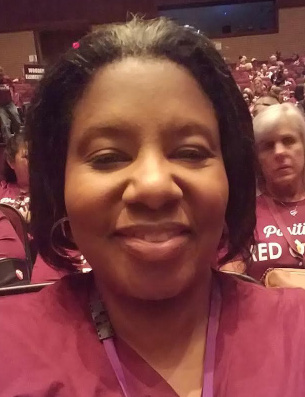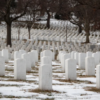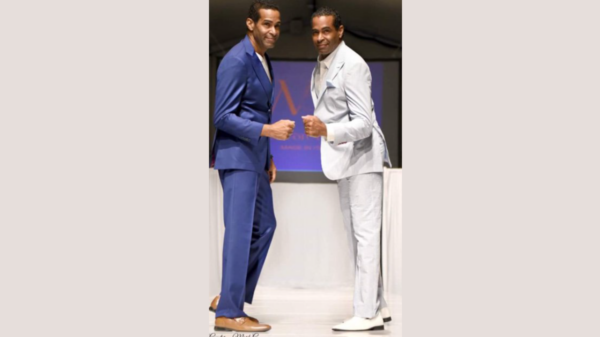BY MYIA GRIFFITH

Spring semester 2020 started like any other – except for the feverish push to continue to raise funds for a grand road trip to Nashville for the National High School Journalism Convention and our preliminary plans for the end-of-year Journalism Gala; not to mention Student Council service projects and celebrations.
The point is, we had grand plans. The mention of yet another infectious disease caught our attention and we should have taken greater notice when it surpassed the 24- or even 72-hour news cycle.
My students and I went about our days, taking time for our restorative circles, or “togetherness time,” the face-to-face engagement that did more than break up the usual learning cycle. Those games of Trash, Speed, Uno™ and Just Dance helped my students build relationships and develop greater camaraderie, strengthening our program overall.
We hosted a “Valentine’s Jam,” complete with a VIP section and amazing parent volunteers and co-workers working behind the scenes. Truly a team effort.
The evening ended with most of us in a crowded gymnasium with arms locked shoulder to shoulder in a swaying huddle as the DJ blasted Aerosmith’s “I Don’t Want to Miss a Thing.”
That was February 13.
A month later, we would be one week into the world’s longest Spring Break.
A CHANGE IN PLANS
This piece is supposed to be about my experience teaching during the COVID-19 pandemic. Some might question why I spent the first 200 words NOT discussing STAAR testing, learning objectives, bench-mark testing or homework.
As I prepared to capture with words the experience of educating students during a time when the world turned upside down, what I remembered first was most important – the one thing that was missing most during the height of the pandemic: authentic human interaction.
When we didn’t return to school the third week of March, then the fourth, I remember students rejoicing at what they thought was the ultimate vacation opportunity. I reflected on the editorial cartoon that one of my students created entitled “COVID-19 World Tour” long before a high volume of cases was reported in the U.S.
THE DIGITAL DESERT
For the month of April, still no in-person learning – but “asynchronous” lessons were mandated. Internet-ready devices were distributed to families as needed, one per household. The disparity between tech-savvy and those lacking WiFi access at home gave this generation of students a fresh look at the “haves and have nots.”
Some parents opted for paper-based assignments, forcing teachers to create on-line assignments and additional activities that could be completed on paper in hopes that students would put in the effort to do the work.
A nice gesture, but not a game changer for families who had 2, 3, 4 or more children across various grade bands. For example, the elementary and middle school students were asynchronous because the high school students had to be in class according to their scheduled time in order to meet requirements for course-work.
So if Mike is a high-school junior, his younger siblings had to wait for him to finish with his classes before they could take turns to log in and do their asynchronous assignments for their six different classes.
The school community was a virtual ghost town (no pun intended). We were allowed to come to the campus only a few staffers at a time on certain days of the week -based on last name and department, to ensure social distancing.
We retrieved our most essential items and made copies of the glorious packets for students as needed, then we retreated to the safety of our homes where we could resume asynchronous lessons for our on-line students – the ones who chose to show up and learn despite the circumstances.
THE GAP
I have heard claims of a learning “gap;” that students just didn’t (or couldn’t) learn during the forced virtual landscape. That’s not 100% across the board. I have proof.
However, I do know that some students were left to tend to themselves and did not have structured guidance to ensure follow through on academic responsibilities.
We’re all paying for that now with students whose social-emotional and academic growth has been stunted. Learning deficiencies seem to be most prevalent among students who did not fare well during the pandemic.
The switch to virtual learning platforms wasn’t a hardship for those of us who had already used on-line learning management systems like Google Classroom, Canvas and Nearpod.
It was quite interesting when students reached out, not for help with assignments, but to request a special weekly Zoom meeting just to check-in – have our “togetherness time.”
Students who would have squealed with delight at the prospect of school being closed were now wishing for time with their classmates – and their teachers!
When May rolled around and the campuses were empty, I had a special task to consider: What is the best way to distribute all of these yearbooks?
Yes, we actually completed our yearbook, and our publisher worked miracles with a skeleton crew at their plant to get thousands of yearbooks printed, packed and shipped on time. A precious co-worker and friend volunteered her time to assist with drive-thru yearbook distribution.
A BREAK IN TRADITION
Typically, students would enjoy this tradition – but no students were allowed on campus this time around. Since we still had to deal with our social distancing rotation, I made sure I had my principal’s permission to be on campus for several consecutive days.
We had a “drop box” for parents to place their payments (no-contact service) and all of the yearbooks were packaged in a protective plastic sleeve that we delivered with gloved hands.
As parents filed through the line, several of my journalism students stopped by (rolled by) to say their good-byes. One student brought her mom, and they drove through with huge smiles. My student asked if she could jump out of the truck to give me a hug, and I reluctantly told her that I couldn’t do it – because of the “rules.”
We didn’t know at the time how easily COVID-19 could be spread, or who was carrying the virus and was unaware. So, I got as close as I could to the truck and we performed air hugs and blew kisses while we waved goodbye to each other.
She was part of the group that continued to meet for weekly virtual check-ins which eventually fizzled out as those students prepared for the start of their high school career.
TEARS, AND MORE TEARS
In November, this young lady’s mother, whose smile I can still remember vividly, died in a tragic accident at home. We were back on campus for classes and when the counselor came to my classroom to tell me the news, she ended up covering my class. I walked out, devastated, trying desperately to hide my tears from my students.
The Friday before Thanksgiving, I visited the young lady (she’s an only child) and her family who had gathered to celebrate the mother’s life. I fought tears again as I stood at the door, reluctant to cross the threshold.
Despite how badly I wanted to just hold my student and grieve with her – or laugh whatever would comfort her, I kept my distance.
Earlier that week, I found out that I had been exposed (“close contact”) to students in class who had tested positive for COVID-19. With even the remote possibility that I may be carrying the dreadful virus, I dared not bring more tragedy to that family. The interaction was awkward at best.
After the Thanksgiving break, some were still gathering for large family meals and the positive cases began to spike.
More students were missing from class that was a blessing to some kids who enjoyed the quiet, the opportunity for more small-group interaction with teachers, and the chance to roam the halls without the usual traffic jams that 1,500+ middle schoolers bring. Masks were mandated, but didn’t do much good when worn incorrectly.
I split my time between my in-person students and had to steal away to a quiet place – a conference room – to have my weekly meetings with all six of my classes, plus another student group I advised.
NEVER-ENDING SITUATION
We made it work. We had dauntless substitute teachers who stepped up, and when we still came up short, fellow teachers split classes to make sure students were properly supervised. We showed grace to our students who struggled, especially those whose immune systems were so compromised that the coronavirus put them in the hospital for weeks at a time.
We listened to our students, to each other, and tried to provide support while we each fought our own war against this virus that no one thought would still be a buzz-word two years later.
Like the Bounty advertisement that shows the desperate attempt to stop the spilled liquid from damaging everything in its path, my family avoided COVID-19 at all costs. I even had a plastic shower curtain bunker built around my teacher’s desk then I realized that I don’t usually teach from behind my desk.









